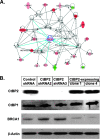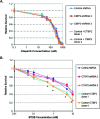BRCA1 expression is epigenetically repressed in sporadic ovarian cancer cells by overexpression of C-terminal binding protein 2
- PMID: 23730208
- PMCID: PMC3664992
- DOI: 10.1593/neo.121674
BRCA1 expression is epigenetically repressed in sporadic ovarian cancer cells by overexpression of C-terminal binding protein 2
Abstract
Introduction: Ovarian cancer is the leading cause of mortality from gynecological malignancy despite advancements in novel therapeutics. We have recently demonstrated that the transcriptional co-repressor C-terminal binding protein 2 (CtBP2) is overexpressed in epithelial ovarian carcinoma.
Materials and methods: Reverse-transcribed cDNA from CtBP2 wild-type and knockdown ovarian cancer cell lines was hybridized to Affymetrix Gene 1.0 ST microarrays, and differentially expressed genes were studied. Immunohistochemical analysis of CtBP2 and BRCA1 staining of ovarian tissues was performed. Chromatin immunoprecipitation (ChIP) and luciferase assays were carried out. The effect of the drugs 4-methylthio-2-oxobutyric acid (MTOB) and poly(ADP-ribose) polymerase (PARP) inhibitor Olaparib on CtBP2 wild-type and knockdown cell lines was examined using methylthiazol tetrazolium assays and an xCELLigence System.
Results: Eighty-five genes involved in DNA repair, mitotic checkpoint, nucleosome assembly, and the BRCA1 network were differentially regulated by CtBP2 expression. ChIP and luciferase reporter assays using a BRCA1 promoter-regulated luciferase construct indicated that the CtBP2 complex binds the BRCA1 promoter and represses BRCA1 transcription. Immunohistochemistry illustrated a significant inverse CtBP2 and BRCA1 expression in a panel of malignant ovarian tumor tissues. The CtBP2 inhibitor MTOB suppressed ovarian cancer cell survival in a CtBP2-dependent manner. Ovarian cancer cells with CtBP2 knockdown did not display increased sensitivity to the PARP inhibitor Olaparib.
Conclusion: CtBP2 is an ovarian cancer oncogene that may play a significant role in epigenetically silencing BRCA1 function in sporadic epithelial ovarian cancer. CtBP2-specific inhibitors, such as MTOB, may be effective adjunct therapies in the management of patients with CtBP2-positive ovarian carcinoma.
Figures




References
-
- Altekruse S, Kosary C, Krapcho M, Neyman N, Aminou R, Waldron W, Ruhl J, Howlader N, Tatalovich Z, Cho H, et al. SEER Cancer Statistics Review, 1975–2007. Bethesda, MD: National Cancer Institute; 2010.
-
- Chinnadurai G. CtBP, an unconventional transcriptional corepressor in development and oncogenesis. Mol Cell. 2002;9:213–224. - PubMed
-
- Chinnadurai G. Transcriptional regulation by C-terminal binding proteins. Int J Biochem Cell Biol. 2007;39:1593–1607. - PubMed
Publication types
MeSH terms
Substances
LinkOut - more resources
Full Text Sources
Other Literature Sources
Medical
Molecular Biology Databases
Miscellaneous
